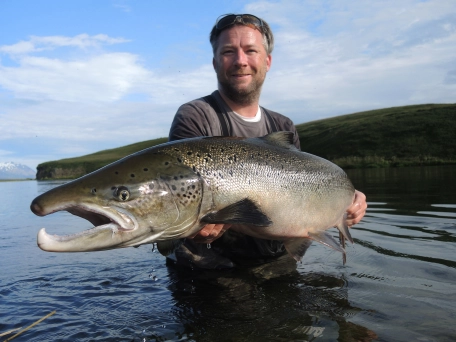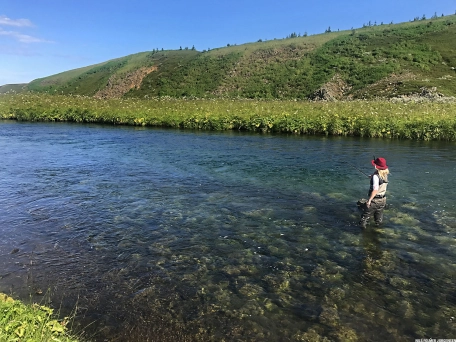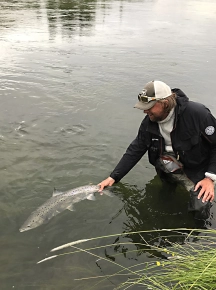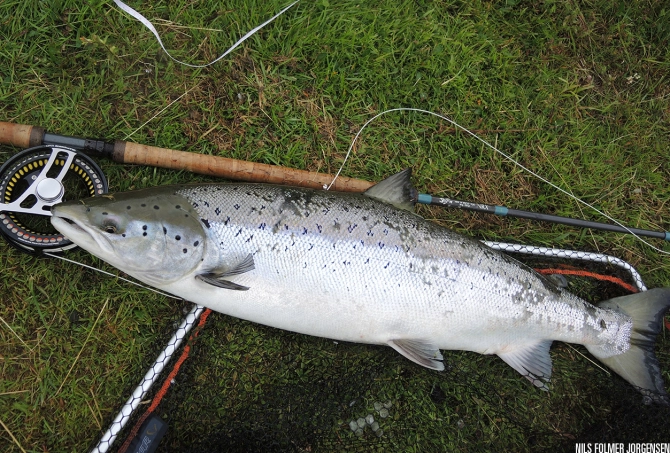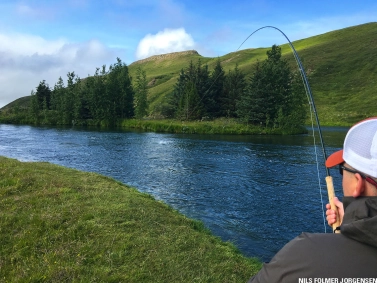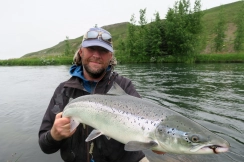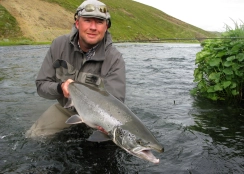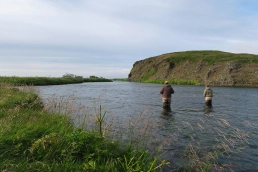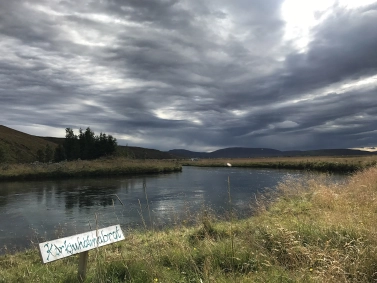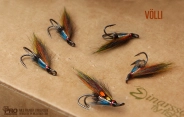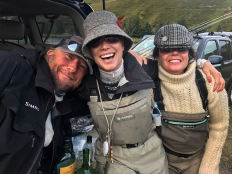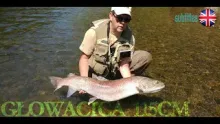Laxá í Aðaldal AKA Big Laxa is probably the most legendary salmon river in Iceland. Not only is the river big, but so are the salmon.
It’s probably the most legendary salmon river in Iceland. Not only is the river big but so are the salmon. But it took dynamite to keep it like this. Here is a story about a river that has gone through many challenges, but is still favored by many anglers from around the world, joining increasing number of victims of the Aðaldal addiction.
We are in the north of Iceland
close to the town Húsavík. Not far from Húsavík is the valley Aðaldalur which means "the first valley". Through the valley runs the famous river Laxá í Aðaldal which means "the salmon river in the first valley".
Under Icelandic circumstances this is a large river. It is shaped with many wide stretches, but also narrow areas with fast water pushing in between islands. Generally it is characterized by a calmly flowing water that is said to do something special to the mind. The valley is rich in green, but barren areas of old lava reveal the drama of the past.
You will find The Big Laxa as Laxá í Aðaldal is also called, in almost any book written about fly fishing in Iceland. It is legendary for many reasons. It’s first of all famous for its large salmon, which are fished on the two beats, Laxámyri and Nessvæði (Nes). These beats are on the lower part of the river. The salmon meet a dam after these beats, and it's not possible to pass.
Above the dam is what many rate as the world's best brown trout fishing and I'm tempted to agree. We are here visiting the upper salmon beat called Nes, an area with spirit and a history that can get most anglers' attention.
In the "good old days",
the river produced an amazing amount of big salmon. When I rate big salmon in Iceland, that is fish above 100 cm or some 40 inches. Most rivers in Iceland don't produce salmon this large, but they are quite normal in Laxá í Aðaldal. In most Icelandic rivers an 85 cm or 33 inch salmon is big. For me, this is a small fish if caught in Laxá í Aðaldal.
Nils Folmer Jørgensen
The river was first fished by the Brits like many other rivers, and looking back in history shows catches that we only dare to dream of today. Pictures of fine fishermen in their tweed sitting on the grass banks of Laxá with several fish over 100 cm after the day, shows what the river was made off back then.
On the bank of the pool Höfdahylur you will find a stone monument of Icelandic Jakob V. Hafstein and his 36 lbs/18 kilo salmon. The big salmon took a size 2 Jock Scott in 1942. Like many others, I often take a minute to envision this when going to this pool. The water in Höfdahylur runs quite calmly until getting closer to the "neck" of the pool where it picks up speed. The surface is still calm in the fast water, and you always see a wave chasing the fly before the final take.
It's classic Laxá fishing, which gets you heart rate up every time, when you wonder if it's one of the monsters that this river holds.
Nils Folmer Jørgensen
Unfortunately most
salmon were killed in those days, and that is one of the reasons for the salmon stock recline. Like any other river, taking the fish that come back to the river for spawning is where they are most sensitive. There are also stories of net fishing, which of course doesn't make things better. It's also known for a fact that the river been fished with salmon traps in in periods between 1890 to 1940.
The big threat for the whole river and valley was in the late sixties. People from the nearest bigger town, Akureyri, overruled the locals and decided to build a big dam on the upper part of the river, which is called Laxádal. They were going to flood the whole valley and ruin land - and of course effect the fishery. There was no environmental considerations, and not even the local would benefit from the electricity produced. There were protests from the locals, but the large community of city people started building the dam.
One day a group of locals had had enough and put a dramatic end to these city people's plans. The first time the group tried to blow up the dam with dynamite, it did not work.
Yes you read it right: blow it up!
The second time, one of the guys used some knowledge that he had picked up while reading a novel where somebody blew up something under water. That brought the idea of putting the dynamite in plastic, under water, and let the current push it against the concrete. It worked, and Laxá was free!
Of course this was not a legal operation, but the perpetrators are still walking free. They are not considered criminals, but local heroes. We often have one of the heroes along the river. Nobody talks about it, but they know. If you visit, you can try to guess who they are.
The dam was blown up in 1970.
The river eventually got
a new more modern dam in 1973 but not on the same terms as the first attempt. This dam still stands today separating the trout and salmon beats. There is one small beat below the new dam called Hraun which once was producing good numbers of salmon.
But eventually it has been filling with sand, and the salmon are not there like they use to be. It is now sold as a trout beat but a salmon gets caught now and then.
More sand has been building up further down river, also ruining spawning grounds. The problem with this sand is that is always moving. It has a fine black structure and you can’t see the bottom when wading on it even though it’s shallow water. Some places you sink slowly into the sand because it’s moving. But there are still many good spawning grounds around and the conditions are slowly bettering.
So the salmon
of the Big Laxá have had a tough past, and catches have gone dramatically down. But like many places in Iceland, things have changed for the better. The salmon traps are gone, net fishing is forbidden like in most rivers in Iceland, and in 1992 catch & release was introduced.
It was time to do something before this unique river was completely ruined.
The dam is here to stay, but the things that can be done to make it better are happening! And it's paying off. But it takes a long time to build up the fish stocks, and will it ever be the same again? Well, the fishing is getting better for sure, and the fish are well spread out on the whole river.
The river produces an average over 1,200 salmon per year now and the average size is increasing. In the years I have been fishing Big Laxá, I have never seen such a big average size as now. They might not be 120 cm or 47", but we are sure they are there.
Then there are always the stories. In 1987, an angler hooked a big one from a boat in the pool Vitaðsgjafi. He got pulled all the way down through the pools Presthylur, Þvottastrengur, Kirkjuholmi and lost the fish in the pool Skriðúflúð. The salmon was assumed to be around 130 cm or a whopping 51 inches!
In 2014, I had the honor
of landing the biggest salmon of the season on Big Laxá. I was fishing the pool Langaflúð and had actually passed the normal taking spot. After the main pool where the water becomes very calm, a wave rose shortly behind my HKA Sunray as it was turning the last part of the swing. I had a solid take and I was in. It’s simply the best felling when lifting to rod into something that does not follow the strike but makes a few deep head shakes before taking off. The fish hammered off to the opposite side of the river which is very wide on that particular location. Then it jumped three times and I could see it was big. I was assuming a 100 cm salmon had taken the fly - or a least hoping to break the magical 100 cm mark. The fish took me downstream to the next pool called Beygjan, where I got the fish close and saw it clearly for the first time. It was not only 100 cm, but much bigger!
Closer to the pool at Knútsstaðir, I finally lifted the net under the fish. It was huge! The biggest I have ever seen on this river. It got it measured to 112 cm or 44 inches, which turned out to be the biggest salmon caught during the 2014 season in Iceland - something the Nessvæði almost produces each season.
A bonus when fishing the Nes beat is sharing an experience with the locals like the legends Volli, Kruani, Steini, Arni Petur and Hemmi. They really show joy on your behalf making the experience even better. They never seem to be able to get enough of it; the joy from record breaking anglers. They are all guides on the Nes, and do their job with heart and soul.
They only guide on the Nes, so they know their work. My addiction to the river and the people got me to get out of guiding retirement and join the family on the Nes, and it has been a pleasure from day one.
A great fishing trip not only catching fish, but also made of the people you have around you. The Nessvæði team will not fail there for sure!
Nils Folmer Jørgensen
So, the big fish
are there, and my fish was probably not the biggest one in the river that year. Icelandic musician and lover of the river Bubbi Morthens claims he has seen an even bigger one in the very same pool. Quite a few big fish have been lost without having visual contact with them.
During the recent
years the river has been fishing really well already from the opening day, which is the July 1st on Nes. Years back, you really had to work to get some action on the opening days, but the first three days of the 2016 season was probably the best opening ever! Some fish were already colored, showing that some had entered the river already in late May. These days are actually sold rather cheap, so some guys got great value for their money.
The 2016 season gave us a river filled with big fish. To make it clear, Big Laxá is not a place to get many fish. Every salmon is a trophy! But in the right moment, place and with a convincing technique, magic can happen You never know. It's a challenging river where just throwing out a big Snaelda probably won’t give you the full experience of what this river can do.
During three days
July fishing in 2016, I landed 19 salmon. This was a record catch for me. With this being a big fish year, it was strange that only one of mine was over 100 cm. Another funny thing is that the media don't bother about a record number, but only size. Different story, but it shows what can happen.
In early September, I set yet another record with 27 salmon landed in three days with six over 100 cm. On my birthday, I landed 10 salmon with four over 100 cm, the biggest one being 108 cm or 42.5 inches. This is something I would never think was possible, but again it shows that you never know. It also shows that the river is recovering from the tough years. Catching four salmon over 100 cm in one day is really crazy, and a good catch no matter where you go in the world. You will meet people who have fished all their life in Iceland, and not come close to the 100 cm mark. Of course you need to fish the rivers where the are, but still…
The 2017 season
also started earlier than usual even though there weren't as many salmon as in 2016. I fished my usual July days and landed 11 salmon with two over 100 cm. It was hard work and you really need to know the river well to get good results.
In late July, the river "shut down" due and unusual long and hot heatwave. The river is shallow on the upper part and too much sun and no wind over long periods heats the water significantly. It went up to 21 degrees, which is the warmest I have experienced in Iceland, and the salmon are simply off. Some guests actually went swimming in the river instead of fishing!
The heat ruined the August fishing and runs. It was really tough, but in the end of August, the big ones woke up again. In the pool Beygjan, I landed the salmon with the biggest girth I have seen in Iceland. It was 106 cm long and 60 cm in girth! The day after a 103 cm followed from the classic autumn pool Presthylur. Then a 96 cm and some smaller. Suddenly the river woke up after the heat. Luckily this "dead river" happens very rarely, but after this tough period, I was more grateful than I would normally be for these big fish.
Nils Folmer Jørgensen
The river is,
as earlier mentioned, mostly wide and fished most effectively with two hand rods between 12 and 14 feet. Don't use stiff rods since it's best to fish quite small flies, and a stiff rod will straighten or pull out the hook.
Only one time have I added a sink tip, but that was during a flood where the water was colored, which rarely happens. Otherwise, it's floating lines and long tapered leaders only. Easy and fun to cast. Some would say real fly fishing, and it's by far the most effective technique on this river.
The fish in the river are known for following the fly time after time. It's impossible not to notice the huge wave after the fly. It gets the heart pumping. It is a very visual fishing, which makes it much more fun than sinking lines and large tube flies. People try them but they do not seem to work. On the contrary, actually: it ruins the pools, especially for the people coming to a pool after you. I recommend not putting the heavy duty stuff in here.
Some years
quite a few fish are going for the Sunray Shadow but double hooked salmon flies in sizes 6 to 12 are by far the best. Not many try them, but I have had good fishing on big hitch flies also. I have fished over salmon several times that have not reacted at all to the regular flies, but after changing to hitch, they rose right away.
I have not gotten any reactions to small hitch flies, which we normally fish here in Iceland, but bigger Sunray types 5-8 cm long seem to get the fish going.
One thing that I find unique on this river compared with experiences from other rivers I fish, is that you get several casts to the same fish. On most smaller rivers, either the fish will take or get spooked. On the Big Laxá, it's different. I have tried this many times. I remember Hemmi casting to a fish with all the flies in the box without any reaction. But suddenly, it took his little hitch tube and a huge 104 cm salmon made the day.
Speaking of flies, many salmon anglers say that patterns do not matter. I don't agree, and maybe they would reconsider after this story. In short, Hemmi and Bjoggi were fishing the pool Stiflan, which holds a lot of salmon. Bjoggi was raising fish all the time. He had never had so much action before. Hemmi wasn't getting a single fish to his fly no matter what he put on. Bjoggi gave him the same fly he was fishinf, and now Hemmi was also in business. The fly is called Radian. The other flies were the same size, so pattern does matter! It's not the only story of its kind.
My best flies in Nes are without doubt my own patterns such as Erna, Autumn Hooker, Radian, Beygjan, Oseyri, Stilfan and Metalizer, and also the local legend Pétur Steingrímsson's Metallica fly. Not to mention the Night Hawk, which is an absolute must. All on size 6 to 12 doubles. Bring some singles, since there can be weed in the water during heatwaves.
The Nessvæði
has recently been divided into 3 beats and is fished with 3 rods on each beat. Each rod has a private room in the lodge. The lodge is not the most fancy one in Iceland, but kept in the original spirit, which it seems that the guests prefer.
The lodge has all that you need, and a lot of stories come from the walls. It is a full service lodge, meaning that you get three meals per day, so you don't have to bring anything other than special needs for drinks. There is a jacuzzi, which is very comfortable – not least with a good whiskey after a nice day on the river.
Nes is a family run operation and has been so for six generations.
The season is from the July 1st to September 21st. Prime time is normally the last week of July and early August, but things might be changing since fish are arriving earlier. We need a 10 year statistic to get a better picture of this.
Facts
Follow Nes on Facebook: Laxá í Aðaldal - Nessvæðið
Contact for guiding: nj@ranga.dk or biglaxa@gmail.com
Driving from Reykjavik
takes about 5-6 hours, but if you fly into Akureyri, it only takes 45 minutes to drive to last bit. If you hire a guide, he can pick you up in Akureyri.
For the record, I would advise anglers visiting the river for the first time to hire a guide! I hired a guide the first time I was there, and learned important things about the river. I fished many places where I would never expect to find salmon. It's a very special river. Trust me, you need a guide here.
If you want to go for the big one
in a atmosphere like nothing else in Iceland, Laxá í Aðaldal’s Nessvæði is where to be. This is the Icelandic version of the famous Norwegian river Alta.
Nils Folmer Jørgensen
- Log in to post comments

